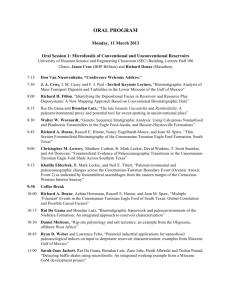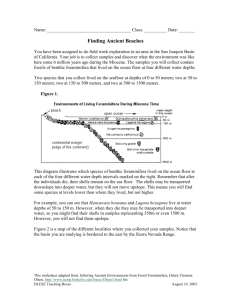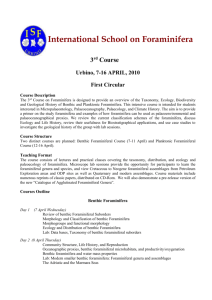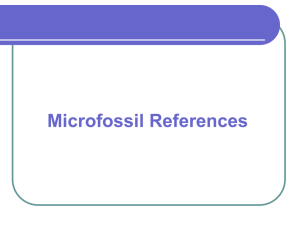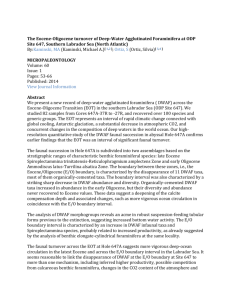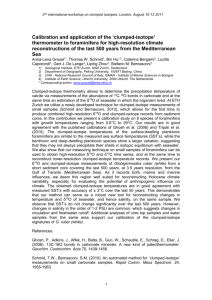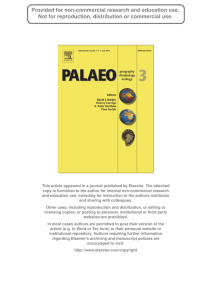Adercotryma (Foraminifera) in the deep Pacific Laia Alegret and Ellen Thomas
advertisement
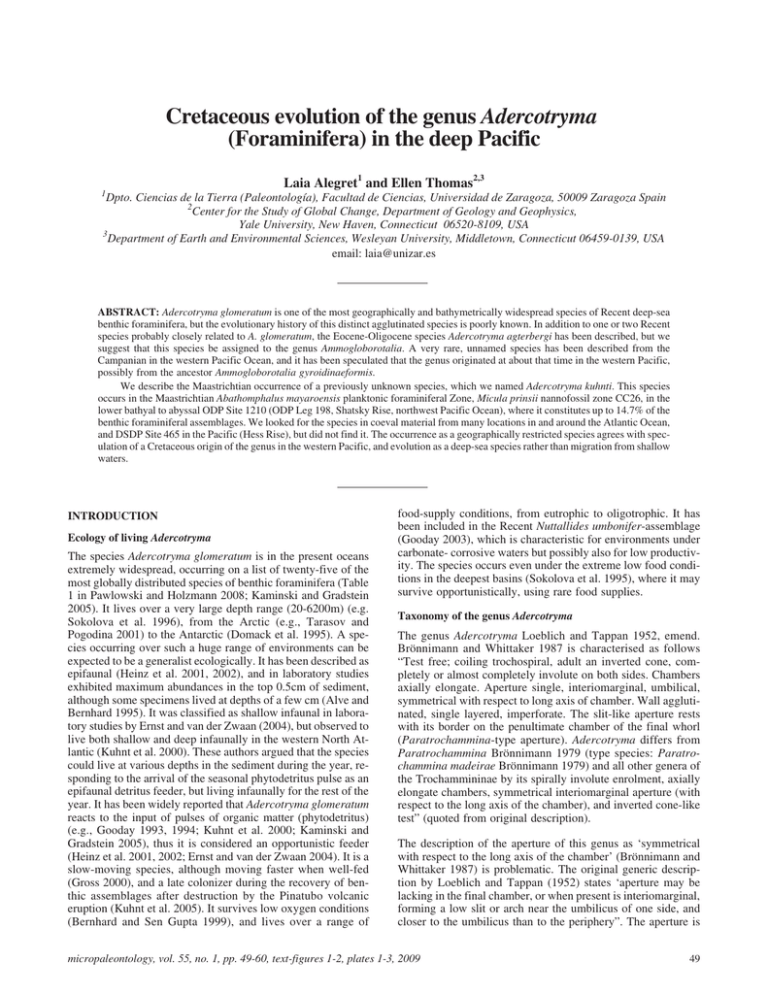
Cretaceous evolution of the genus Adercotryma (Foraminifera) in the deep Pacific 1 Laia Alegret1 and Ellen Thomas2,3 Dpto. Ciencias de la Tierra (Paleontología), Facultad de Ciencias, Universidad de Zaragoza, 50009 Zaragoza Spain 2 Center for the Study of Global Change, Department of Geology and Geophysics, Yale University, New Haven, Connecticut 06520-8109, USA 3 Department of Earth and Environmental Sciences, Wesleyan University, Middletown, Connecticut 06459-0139, USA email: laia@unizar.es ABSTRACT: Adercotryma glomeratum is one of the most geographically and bathymetrically widespread species of Recent deep-sea benthic foraminifera, but the evolutionary history of this distinct agglutinated species is poorly known. In addition to one or two Recent species probably closely related to A. glomeratum, the Eocene-Oligocene species Adercotryma agterbergi has been described, but we suggest that this species be assigned to the genus Ammogloborotalia. A very rare, unnamed species has been described from the Campanian in the western Pacific Ocean, and it has been speculated that the genus originated at about that time in the western Pacific, possibly from the ancestor Ammogloborotalia gyroidinaeformis. We describe the Maastrichtian occurrence of a previously unknown species, which we named Adercotryma kuhnti. This species occurs in the Maastrichtian Abathomphalus mayaroensis planktonic foraminiferal Zone, Micula prinsii nannofossil zone CC26, in the lower bathyal to abyssal ODP Site 1210 (ODP Leg 198, Shatsky Rise, northwest Pacific Ocean), where it constitutes up to 14.7% of the benthic foraminiferal assemblages. We looked for the species in coeval material from many locations in and around the Atlantic Ocean, and DSDP Site 465 in the Pacific (Hess Rise), but did not find it. The occurrence as a geographically restricted species agrees with speculation of a Cretaceous origin of the genus in the western Pacific, and evolution as a deep-sea species rather than migration from shallow waters. INTRODUCTION Ecology of living Adercotryma The species Adercotryma glomeratum is in the present oceans extremely widespread, occurring on a list of twenty-five of the most globally distributed species of benthic foraminifera (Table 1 in Pawlowski and Holzmann 2008; Kaminski and Gradstein 2005). It lives over a very large depth range (20-6200m) (e.g. Sokolova et al. 1996), from the Arctic (e.g., Tarasov and Pogodina 2001) to the Antarctic (Domack et al. 1995). A species occurring over such a huge range of environments can be expected to be a generalist ecologically. It has been described as epifaunal (Heinz et al. 2001, 2002), and in laboratory studies exhibited maximum abundances in the top 0.5cm of sediment, although some specimens lived at depths of a few cm (Alve and Bernhard 1995). It was classified as shallow infaunal in laboratory studies by Ernst and van der Zwaan (2004), but observed to live both shallow and deep infaunally in the western North Atlantic (Kuhnt et al. 2000). These authors argued that the species could live at various depths in the sediment during the year, responding to the arrival of the seasonal phytodetritus pulse as an epifaunal detritus feeder, but living infaunally for the rest of the year. It has been widely reported that Adercotryma glomeratum reacts to the input of pulses of organic matter (phytodetritus) (e.g., Gooday 1993, 1994; Kuhnt et al. 2000; Kaminski and Gradstein 2005), thus it is considered an opportunistic feeder (Heinz et al. 2001, 2002; Ernst and van der Zwaan 2004). It is a slow-moving species, although moving faster when well-fed (Gross 2000), and a late colonizer during the recovery of benthic assemblages after destruction by the Pinatubo volcanic eruption (Kuhnt et al. 2005). It survives low oxygen conditions (Bernhard and Sen Gupta 1999), and lives over a range of food-supply conditions, from eutrophic to oligotrophic. It has been included in the Recent Nuttallides umbonifer-assemblage (Gooday 2003), which is characteristic for environments under carbonate- corrosive waters but possibly also for low productivity. The species occurs even under the extreme low food conditions in the deepest basins (Sokolova et al. 1995), where it may survive opportunistically, using rare food supplies. Taxonomy of the genus Adercotryma The genus Adercotryma Loeblich and Tappan 1952, emend. Brönnimann and Whittaker 1987 is characterised as follows “Test free; coiling trochospiral, adult an inverted cone, completely or almost completely involute on both sides. Chambers axially elongate. Aperture single, interiomarginal, umbilical, symmetrical with respect to long axis of chamber. Wall agglutinated, single layered, imperforate. The slit-like aperture rests with its border on the penultimate chamber of the final whorl (Paratrochammina-type aperture). Adercotryma differs from Paratrochammina Brönnimann 1979 (type species: Paratrochammina madeirae Brönnimann 1979) and all other genera of the Trochammininae by its spirally involute enrolment, axially elongate chambers, symmetrical interiomarginal aperture (with respect to the long axis of the chamber), and inverted cone-like test” (quoted from original description). The description of the aperture of this genus as ‘symmetrical with respect to the long axis of the chamber’ (Brönnimann and Whittaker 1987) is problematic. The original generic description by Loeblich and Tappan (1952) states ‘aperture may be lacking in the final chamber, or when present is interiomarginal, forming a low slit or arch near the umbilicus of one side, and closer to the umbilicus than to the periphery”. The aperture is micropaleontology, vol. 55, no. 1, pp. 49-60, text-figures 1-2, plates 1-3, 2009 49 Laia Alegret and Ellen Thomas: Cretaceous evolution of the genus Adercotryma (Foraminifera) in the deep Pacific not visible in the type figures of Adercotryma glomeratum, the type species of the genus (Lituola glomerata, Brady 1878), and the description states ‘Aperture at the inner margin of the terminal chamber, near the exterior of the corresponding segment of the previous convolution, simple, often obscure’, thus does not make clear what its exact position is. Loeblich and Tappan (1987, p. 81) state that ‘aperture a low interiomarginal arch or slit, about one-half to two-thirds the distance from the periphery to the umbilicus’, i.e., not symmetrical with respect to the long axis. The figures (Plate 67, figs. 1-3) show the aperture in asymmetrical position, as described above, in one specimen (Figure 1). Figures 2 and 3, however, are described as ‘edge and side views of adult showing aperture extending to the umbilicus’ (p. 20), thus showing an even more asymmetrical position than described in the text (p. 81). having a flap covering its umbilicus, and a more evolute spiral side (Gradstein and Kaminski 1989). In all specimens figured by Gradstein and Kaminski (1989), the dorsal side is flat with chambers in the early whorl visible, and the spiral side thus is at least partially evolute. The figured specimens are all much more evolute on the spiral side than Recent species of Adercotryma, which does not agree with the generic description of Adercotryma by Brönnimann and Whittaker (1987). The generic description of the genus Ammogloborotalia (Zheng 2001) states that this genus resembles Adercotryma in its coiling along a vertical axis, but differs from it in being trochospiral, with the dorsal side evolute (Kaminski et al. 2007). We thus argue that the species agterbergi should be attributed to the genus Ammogloborotalia rather than to Adercotryma (Kaminski et al. 2007; Kaminski 2008). Species assigned to the genus Adercotryma. Ammogloborotalia agterbergi (Gradstein and Kaminski) is commonly found in bore holes in the Central North Sea, where it ranges from the upper-middle Eocene to the early Oligocene (Gillmore et al. 2001; Kaminski and Gradstein 2005), and in middle Eocene to lower Miocene sediments in cores offshore Norway, as well as in the Arctic Ocean (Kaminski 2007). It has been reported as Insculptarenula subvesicularis (Hanzlíková) in the Oligocene to Miocene of the Beaufort-MacKenzie Delta (Schröder-Adams and McNeil 1994), and as a rare component of the assemblages in lower Oligocene sediments from the Mainz Basin, Germany (Grimm 2002). It has also been documented from the lower-middle Eocene sediments from the Mendi Group of New Guinea (Kaminski and Gradstein 2005), and from lower Miocene sediments in the Arctic Ocean, indicating a wide geographic distribution. Adercotryma glomeratum (Brady 1878) is the type-species of the genus Adercotryma. This species was first described in material recovered during the Challenger North-Polar Expedition (Brady 1878), and later recognised in dredgings from across the world, including the Pacific and Atlantic Oceans (e.g., Barker 1960; Schröder 1986; Charnock and Jones 1990; Hughes et al. 2000). Adercotryma glomeratum has four chambers in its final whorl, and a test with a maximum diameter at the spiral side. Its type material is Recent, and Loeblich and Tappan (1987) give a range of Holocene for the genus, although Jones et al. (2005) describe Adercotryma glomeratum from Eocene deposits in the Spanish Pyrenees. The Recent subspecies A. glomerata (Brady) subsp. antarctica Saidova 1975 was first described from upper bathyal depths in the Antarctic Sea. The test is smaller than that in A. glomeratum, elongate, and it has three chambers in the last whorl; no details are given on the aperture (Saidova 1975). Adercotryma wrighti Brönnimann and Whittaker 1987 has been found in Recent material from the British Isles, at a depth of ~16 to 20 fathoms, although its authors suggested that careful study of specimens previously recorded as A. glomeratum might extend the geographic range of A. wrighti beyond the British Isles. According to these authors, A. wrighti is easily distinguished from A. glomeratum by the overall shape of the test, the presence of only 3 chambers in the last whorl, the shape of the adult chambers and the bilobed apertural features formed by the triangular lip-like projection of the chamber wall (see also Murray 2002). Adercotryma glomeratum antarctica Saidova, however, is also defined as having 3 chambers per whorl, and Brönnimann and Whittaker (1987) did not include a differential analysis, so the difference between these two taxa is not clear. Adercotryma wrighti thus might be a junior synonym of A. glomeratum antarctica, especially since A. wrighti was recognized in the Antarctic waters from which A. glomeratum antarctica was first described (Murray and Pudsey 2004). Adercotryma agterbergi Gradstein and Kaminski 1989 was first identified in lower Oligocene sediments from the Central North Sea, and ranges from middle Eocene through early Miocene (Gradstein and Kaminski 2005), possibly extending to the early Eocene (Gradstein, pers. com. 2008). It has subglobular chambers, four in its last whorl. The test is clearly asymmetric, with a highly convex, involute ventral side and a flat, evolute to partially evolute dorsal (spiral) side (with slight overlapping of chambers of the earlier whorls). The species differs from A. glomeratum (Brady) in having a less conical ventral side, in 50 Kuhnt and Pletsch (2004) describe Adercotryma sp. in the Moroccon Paleocene, but the oldest species assigned to the genus is Adercotryma sp. from the Campanian in the western Pacific (DSDP Sites 196, 198; ODP Site 801; Wightman and Kuhnt 1992; text-fig. 1). No description was given of the species, but the figure shows four to four and a half chambers on the last whorl, a highly convex involute ventral side, broadly rounded periphery, and a flat, somewhat less involute dorsal side. We include a plate (Plate I) with five views of the specimen figured by Wightmant and Kuhnt (1992), for comparison with Adercotryma kuhnti. Listed in the synonymy of Adercotryma sp. is ?Trochammina gyroidinaeformis Krasheninnikov 1974. This species has a convex involute side, and a flat spiral side with slightly overlapping whorls, with 5 to 6 chambers in the last whorl. Specimens figured in Krasheninnikov´s 1974 plates of T. gyroidinaeformis, however, differ from the figured specimens of Adercotryma sp. because they vary from almost fully evolute to evolute with partially overlapping chambers. Other figures of T. gyroidinaeformis (Hemleben and Troester 1984, Pl. 4, figs. 11-13; Moullade et al. 1988; Pl. 8, figs. 4-6) also show a clearly trochospiral species, with a highly convex involute side. Because of this trochospiral character, with the flat, spiral side fully or partially evolute, we assign this species to the genus Ammogloborotalia (Kaminski et al. 2007; Kaminski 2008). Krashninnikov (1974) commented that this species does not fully agree with the description of the genus Trochammina, and might have to be assigned differently. We thus consider the species Adercotryma sp., in Wightman and Kuhnt (1992) as different from Ammogloborotalia gyroidinaeformis because of its involute character. Adercotryma sp. might have evolved from the Ammogloborotalia gyroidinaeformis (Krasheninnikov) group of spe- Micropaleontology, vol. 55, no. 1, 2009 TEXT-FIGURE 1 A, Paleogeographical distribution of continental masses and oceanic basins at the K/Pg boundary (modified from Denham & Scotese 1987). The location of Shatsky Rise ODP Leg 198 and of other sites and sections referred to in this paper are shown. B, Relief map of Shatsky Rise showing location of Leg 198 sites, including Site 1210 (on the Southern High). Modified from Bralower et al. (2002). cies (Kuhnt, pers. comm. 2008). From the Turonian through the Maastrichtian, A. gyroidinaeformis was an important ecological indicator in the abyssal North Atlantic Ocean, in the red deep-sea clays in the western Tethys, and the abyssal Pacific, and abundant in oligotrophic environments (over a wide depth range, middle bathyal through abyssal) with low sedimentation rates and the fine grained, nutrient-poor sediments typically deposited under these conditions (e.g., Kuhnt and Holbourn 2005). We found abundant specimens of a non-previously described species of Adercotryma in uppermost Cretaceous sediments from Ocean Drilling Program (ODP) Leg 198, Hole 1210A, northwest Pacific Ocean. The purpose of this paper is to formally describe a new species of Adercotryma, to compare it to other species of the same genus, and speculate on the evolutionary history of the genus. MATERIAL AND METHODS Specimens of Adercotryma were found in Upper Cretaceous sediments recovered during ODP Leg 198 on Shatsky Rise (paleo-latitude ~10ºN at 65.5 Ma; text-fig. 1A), northwest Pa- cific Ocean. The studied material comes from Hole 1210A, which was drilled at 32°13.4123´N, 158°15.5618´E, at a present waterdepth of 2573.6m (text-fig. 1B). The sedimentary succession includes uppermost Maastrichtian (nannofossil Zone CC26), white to pale orange nannofossil ooze overlain by lowermost Paleocene (foraminiferal Zone P and nannofossil Zone NP1), grayish-orange foraminiferal ooze (10 cm) that grades upwards into a white foraminiferal nannofossil chalk (20 cm), and then into a grayish-orange nannofossil ooze (Bralower et al. 2002; Bown 2005). The boundary between the uppermost Maastrichtian and the lowermost Paleocene is bioturbated, with up to 5-cm-long burrows across the boundary. Uppermost Maastrichtian sediments show severe carbonate dissolution, indicative of deposition below the lysocline. Planktic foraminiferal shells are etched and fragmented, whereas thin-walled earliest Paleocene faunas are well preserved (Bralower et al. 2002). Also indicative of severe dissolution of the upper Maastrichtian sediments is the very high percentage (> 90%) of benthic foraminifers. The lysocline and calcite compensation depth over Shatsky Rise shoaled in the latest Maastrichtian, prior to the K/Pg boundary, and deepened in the 51 Laia Alegret and Ellen Thomas: Cretaceous evolution of the genus Adercotryma (Foraminifera) in the deep Pacific earliest Paleocene (Bralower et al. 2002). Benthic foraminiferal assemblages contain abundant representatives of the cosmopolitan lower bathyal-abyssal Velasco-type fauna, and thus indicate a deep-water paleoenvironment. The assemblages are diverse and contain abundant buliminid taxa in the uppermost Cretaceous, suggesting a relatively high food supply to the seafloor (Alegret and Thomas 2008). A total of 26 samples from the Upper Cretaceous and lower Paleogene were studied from Hole 1210A. All samples were dried, disaggregated in water with detergent and washed over a 63 mm sieve. Quantitative studies were based on representative splits of 300 or more specimens of benthic foraminifera from the >63 mm fraction, which were obtained with a modified Otto microsplitter. All specimens were picked, identified, counted and mounted on microslides for a permanent record. The illustrated specimens (with the exception of the holotype and the two paratypes) were selected and covered with Au or Pt in order to take Scanning Electron Micrographs. Photographs of the type material were taken with a digital camera attached to a binocular microscope. The holotype and paratypes have been deposited in the National History Museum, Smithsonian Institution, Washington D. C. (collection numbers USNM 573203537205). The rest of the illustrated specimens are deposited at the Department of Geology and Geophysics, Yale University, USA, and at the Department of Earth Sciences, Zaragoza University, Spain. TAXONOMY Superfamily Haplophragmiacea Eimer and Fickert 1899 Family Ammosphaeroidinidae Cushman 1927 Subfamily Ammosphaeroidininae Cushman 1927 Genus Adercotryma Loeblich and Tappan 1952, emend. Brönnimann and Whittaker (1987) Adercotryma kuhnti Alegret and Thomas, n. sp. Plates 2, 3 Description. Test free; globular, planoconvex to fusiform, coiling trochospiral. Chambers slightly inflated, axially elongate, gradually increasing in size, 5 to 6 visible in the final whorl. Sutures distinct, depressed. Aperture single, interiomarginal, a slit (length about one third of the chamber´s width) on the base of the last chamber, extending from the umbilical end of the chamber towards the other side; Paratrochammina-type aperture, resting on the last and penultimate chamber of the final whorl. In some specimens an umbilical flap is clearly visible on the ventral side (Plate 2, figs. 1c, 3c, 4). Wall finely agglutinated on the most involute umbilical side, coarser on the somewhat more evolute dorsal (spiral) side. Two morphotypes have been distinguished. The “planoconvex” morphotype (plate 2, figs. 1-2, 5-6) is truncated spirally and clearly asymmetric, with a slightly evolute to involute flat dorsal (spiral) side and a highly convex, involute ventral side, whereas the “fusiform” morphotype (plate 2, fig. 3; plate 3, fig. 2) is somewhat more planispiral and symmetric, and almost completely involute and convex on both sides. The presence of common intermediate forms between these two morphotypes suggests that they belong to the same species. The holotype (plate 2, figs. 1a-c) belongs to the “planoconvex” morphotype; it has a globular shape, a typically trochospiral, dextral coiling, and 6 chambers in the last whorl. 52 Dimensions (holotype). Maximum diameter 273 µm, thickness 265µm. Plate 2, figs. 1a-c. Collection number USNM 537203. Paratypes. Two paratypes have been designated. Paratype 1 (plate 2, figs. 2a-c) belongs to the “planoconvex” morphotype, is sinistral and has 5 chambers in the last whorl (maximum diameter 192µm, thickness 188 µm), and Paratype 2 (plate 2, figs. 3a-c) belongs to the “fusiform” morphotype and has 6 chambers in the last whorl (maximum diameter 171 µm, thickness 194µm). Collection numbers USNM 537204, 537205. Type level (holotype and paratypes). Sample 1981210A-24H-4(70-72), 220.10 mbsf. Late Cretaceous (latest Maastrichtian), Abathomphalus mayaroensis planktonic foraminiferal Zone, Micula prinsii nannofossil zone (CC26), and nannofossil UC20d subzone (Bralower et al. 2002; Bown 2005). Type locality. Shatsky Rise ODP Leg 198 Site 1210A, northwest Pacific Ocean. Located at 10ºN at 65.5 Ma; present location 32°13.4123´N, 158°15.5618´E, water depth 2573.6m. Lower bathyal-upper abyssal. Abundance. Adercotryma kuhnti makes up 0.33% to 14.7% of the benthic foraminiferal assemblages (text-fig. 2). Type specimens. The holotype (plate 2, figs. 1a-c) and paratypes (plate 2, figs. 2, 3) have been deposited in the micropaleontological collections of the National History Museum, Smithsonian Institution, Washington D. C., with the holotype numbered USNM 537203, the paratypes USNM 537204 and 537205. Remarks. Adercotryma kuhnti differs from most other species of Adercotryma in having more chambers (5 to 6) in its final whorl. Its aperture is covered with an umbilical flap like that present in A. agterbergi (Gradstein and Kaminski 1989) and in well-preserved specimens of A. glomeratum (Loeblich and Tappan 1987), and extends into the umbilicus. Adercotryma kuhnti has 1 to 2 more chambers in the last whorl than Adercotryma glomeratum, and the “fusiform” morphotype is much more symmetric than A. glomeratum, which has been described as asymmetric. Kuhnt (pers. comm., 2008), however, considers that similar morphotypes occur in A. glomeratum, and may represent the microspheric (fusiform) and macrospheric (planoconvex) generations. Adercotryma kuhnti differs from Adercotryma wrighti in having 5 to 6 chambers instead of 3 in the final whorl; the outline of the test is less lobate, and most specimens have an umbilical flap on the ventral side. Adercotryma kuhnti has a more conical ventral side than Ammogloborotalia agterbergi, and it has more (and less inflated) chambers in the last whorl. The test of A. agterbergi is always clearly asymmetric, with one at least partially evolute side, whereas the “fusiform” morphotype of Adercotryma kuhnti is almost symmetric. Figures of the Campanian Adercotryma sp. (Wightman and Kuhnt 1992) (Plate 1) show 4 to 4 and 1/2 chambers in the last whorl, much more strongly depressed sutures, and a strongly asymmetrical shape, while no flap is seen over the aperture in the umbilical region. Distribution. Adercotryma kuhnti has been found only in Maastrichtian (Abathomphalus mayaroensis planktonic foraminiferal Zone, Micula prinsii nannofossil zone CC26) lower bathyal to abyssal sediments on Shatsky Rise, ODP Leg 198, Micropaleontology, vol. 55, no. 1, 2009 TEXT-FIGURE 2 Relative abundance of Adercotryma kuhnti within the benthic foraminiferal assemblages in Hole 1210A, Shatsky Rise. (1) planktic foraminiferal biozones (Bralower et al., 2002); (2) calcareous nannofossil biozones (Bralower et al. 2002; Bown 2005); mbsf: meters below seafloor. 53 Laia Alegret and Ellen Thomas: Cretaceous evolution of the genus Adercotryma (Foraminifera) in the deep Pacific Site 1210, northwest Pacific Ocean. It has been searched for but not found, in Upper Cretaceous (Maastrichtian Abathomphalus mayaroensis and Plummerita hantkeninoides planktonic foraminiferal Zones) and lower Paleocene (Danian) sediments from the central North Pacific (lower bathyal DSDP Hole 465A, Hess Rise), North Atlantic and Caribbean (lower bathyal ODP Hole 1049C at Blake Nose, 8 upper to lower bathyal land sections in and central-East and Northeastern Mexico, the Loma Capiro section in Cuba, two middle bathyal French sections at Bidart and Loya Bay), Southeastern Atlantic, (lower bathyal ODP Site 1262 on Walvis Ridge), bathyal Sites 689 and 690 in the Weddell Sea, Antarctica, upper to middle bathyal Agost and Caravaca sections in Southeastern Spain, and outer shelf-upper bathyal sections Aïn Settara and El Kef in Tunisia) (Thomas 1990a, b; Alegret and Thomas, 2001, 2004, 2005, 2007; Alegret et al., 2001, 2002a, b, 2003, 2004, 2005; Arz et al. 2001; Peryt et al. 2002; Molina et al. 2006; Alegret 2007, 2008). The absence of Adercotryma kuhnti in the aforementioned sections and sites, including the central North Pacific Site 465, suggests that its distribution was restricted to lower bathyal-abyssal sites in the northwest Pacific Ocean, possibly to depths below the lysocline. Interestingly, the Campanian Adercotryma sp. was also described from the western Pacific (Wightman and Kuhnt 1992). Kuhnt (pers. comm., 2007) speculated that this species might have been descended from the widely distributed A. gyroidinaeformis, indicative of bathyal to abyssal oligotrophic conditions (Holbourn and Kuhnt 2005). The presence of Adercotryma kuhnti, as far as known restricted to the western Pacific Maastrichtian, supports the speculation of a Late Cretaceous, western Pacific, bathyal-abyssal origin for the genus. Overall, morphological evolution appears to have proceeded from a highly convex form with one involute and one evolute side (A. gyroidinaeformis) to a highly convex form with two almost completely involute sides (A. glomeratum). The species Ammogloborotalia gyroidinaeformis, Adercotryma sp., and Adercotryma kuhnti succeed each other in time (old to young), with the record of the youngest species ending at the end of the Cretaceous (text-fig. 2). Since we assigned the Eocene-Miocene species agterbergi to the genus Ammogloborotalia, we know of no species recorded in the early Cenozoic. There is a Paleocene Adercotryma sp. (Kuhnt and Pletsch 2004), and the oldest occurrence of A. glomeratum was in the Eocene (Jones et al., 2005). The record of this species is very scarce until the Pleistocene, when it becomes ubiquitous, as described earlier. We do not know the reason of the rarity of Adercotryma in the Cenozoic fossil record as opposed to its more Recent ubiquity. Possibly, the genus was more restricted geographically, as it was in the Maastrichtian, but maybe the tests are not well preserved in the fossil record. The oligotrophic environments of the Campanian Adercotryma sp. and its possible ancestral species Ammogloborotalia gyroidinaeformis contrast with the more eutrophic environments at Site 1210 deduced from the co-occurrence of Adercotryma kuhnti and common buliminids. The Recent species A. glomeratum lives under extremely variable conditions, including eutrophic as well as oligotrophic conditions. The Eocene-Miocene species Ammogloborotalia agterbergi forms part of the Slope Marl Assemblage of the Deep Water Agglutinated Foraminifera (Kuhnt and Kaminski 1989; Kaminski and Gradstein, 2005). This assemblage typically occurs on continental slopes and in slope basins, above the Carbonate Com- 54 pensation Depth, in regions with high sedimentation rates, high terrigenous sediment influx, and high organic flux. The restricted geographic and bathymetric distribution of the Campanian species Adercotryma sp., however, is similar to that of the Maastrichtian species Adercotryma kuhnti (bathyal-abyssal western Pacific), and in strong contrast with the large geographic and bathymetric variability of the Recent species A. glomeratum. The genus probably originated at bathyal to abyssal depths, and thus must have migrated to much shallower depths when the latter species evolved. We do not know with any certainty when the recent species evolved, because we have been able to find only one reference (Jones et al. 2005) to a fossil occurrence (Eocene), but these authors do not figure any specimens. CONCLUSIONS The deep-water species Adercotryma kuhnti occurred in the Maastrichtian (Abathomphalus mayaroensis planktonic foraminiferal Zone, Micula prinsii nannofossil zone CC26), lower bathyal to abyssal sediments recovered on Shatsky Rise Site 1210, northwest Pacific Ocean (ODP Leg 198), where it makes up to 14.7% of the benthic foraminiferal assemblages. The species differs from other species of Adercotryma in having slightly inflated and more chambers (5 to 6) in the final whorl, and in showing a considerable variability in the symmetry of the test, from planoconvex to fusiform. As far as known, the species is restricted to bathyal-abyssal environments in the western Pacific, similar to a possible ancestral species Adercotryma sp. ACKNOWLEDGMENTS We thank Felix Gradstein, Ann Holbourn, Mike Kaminski and Wolfgang Kuhnt for their constructive reviews, and Wolfgang Kuhnt also for the use of the figures in Plate 1. We also thank Raquel Fenero for taking some of the SEM pictures. LA acknowledges funding by project Consolider CGL 2007-63724 (Spanish Ministry of Science and Technology), by a “Ramón y Cajal” research contract, and the FSE (Fondo Social Europeo). ET acknowledges funding by NSF OCE -720049. REFERENCES ALEGRET, L. 2007. Recovery of the deep-sea floor after the Cretaceous/Paleogene boundary event: the benthic foraminiferal record in the Basque-Cantabrian basin and in South-eastern Spain. Palaeogeography, Palaeoclimatology, Palaeoecology, 255: 181-194. ———, 2008. Evolución paleoambiental del tránsito Cretácico/ Paleógeno basada en foraminíferos bentónicos. Revista de la Sociedad Española de Paleontología, 23 (1): 15-30.. ALEGRET, L. and THOMAS, E., 2001. Upper Cretaceous and lower Paleogene benthic foraminifera from northeastern Mexico. Micropaleontology, 47 (4): 269-316. ———, 2004. Benthic foraminifera and environmental turnover across the Cretaceous/Paleogene boundary at Blake Nose (ODP Hole 1049C, Northwestern Atlantic). Palaeogeography, Palaeoclimatology, Palaeoecology, 208 (1-2): 59-83. ———, 2005. Cretaceous/Paleogene boundary bathyal paleo-environments in the central North Pacific (DSDP Site 465), the Northwestern Atlantic (ODP Site 1049), the Gulf of Mexico and the Tethys: The benthic foraminiferal record. Palaeogeography, Palaeoclimatology, Palaeoecology, 224: 53-82. ———, 2007. Deep-Sea environments across the Cretaceous/ Paleogene boundary in the eastern South Atlantic Ocean (ODP Leg 208, Walvis Ridge). Marine Micropaleontology, 64: 1-17. Laia Alegret and Ellen Thomas Plate 1 PLATE 1 Adercotryma sp., Wightman and Kuhnt 1992. Five views of one of the rare specimens of this species, one of which was also shown in Wightman and Kuhnt 1992, Plate 2, figure 5. Specimen from Sample 20-196A-2-1,143-145cm. micropaleontology, vol. 55, no. 1, 2009 55 Laia Alegret and Ellen Thomas: Cretaceous evolution of the genus Adercotryma (Foraminifera) in the deep Pacific ———, 2008. Food supply to the seafloor: crisis after the Cretaceous/Paleogene boundary event. 33rd International Geological Congress, Abstract volume, 1341341.. ALEGRET, L., ARENILLAS, I., ARZ, J.A. and MOLINA, E., 2002a. Environmental changes triggered by the K/T impact event at Coxquihui (Mexico) based on foraminifera. Neues Jahrbuch fur Geologie und Paläontologie, Monatshefte, 2002 (5): 295-309. ALEGRET, L., ARENILLAS, I., ARZ, J.A., LIESA, C., MELÉNDEZ, A., MOLINA, E., SORIA, A.R. and THOMAS, E., 2002b. The Cretaceous/Tertiary boundary impact event: sedimentology and micropaleontology at El Mulato section, NE Mexico. Terra Nova,14 (5): 330-336. ALEGRET, L., ARENILLAS, I., ARZ, J.A. DÍAZ, C., GRAJALES, M., MELÉNDEZ, A., MOLINA, E., ROJAS, R. and SORIA, A., 2005. Cretaceous/Paleogene boundary deposits at Loma Capiro, central Cuba: Evidence for the Chicxulub impact. Geology. 33(9): 721-724. ALEGRET, L., KAMINSKI, M.A. and MOLINA, E., 2004. Paleoenvironmental recovery after the Cretaceous/Paleogene boundary crisis: evidence from the marine Bidart section (SW France). Palaios, 19: 574-586. ALEGRET, L., MOLINA, E. and THOMAS, E., 2001. Benthic foraminifera at the Cretaceous/Tertiary boundary around the Gulf of Mexico. Geology, 29 (10): 891-894. ALEGRET, L., MOLINA, E. and THOMAS, E., 2003. Benthic foraminiferal turnover across the Cretaceous/Paleogene boundary at Agost (southeastern Spain): paleoenvironmental inferences. Marine Micropaleontology, 48: 251-279. ALVE, E., and BERNHARD, J. M., 1995. Vertical migratory response of benthic foraminifera to controlled oxygen concentrations in an experimental mesocosm. Marine Ecology Progress Series, 116: 137-151. ARZ, J.A., ARENILLAS, I., SORIA, A.R., ALEGRET, L., GRAJALES, J.M., LIESA, C.L., MELÉNDEZ, A. MOLINA, E. and ROSALES, M.C., 2001. Micropaleontology and Sedimentology of the Cretaceous/Paleogene boundary at La Ceiba (Mexico): impact-generated sediment gravity flows. Journal of South American Earth Sciences, 14 (5): 505-519. BARKER, R.W., 1960. Taxonomic notes on the species figured by H.B. Brady in his report on the foraminifera dredged by H.M.S. Challenger during the years 1873-1876. Tulsa: Society of Economic Paleontology and Mineralogy, Special publication 9, 238 pp.. BERNHARD, J. M. and SEN GUPTA, B. K., 1999. Foraminifera of oxygen-depleted enviornments. In: Sen Gupta, B. K., Ed., Modern Foraminifera, 201-216. Dordrecht: Kluwer Academic Publishers, Netherlands. BOWN, P. 2005. Selective calcareous nannoplankton survivorship at the Cretaceous-Tertiary boundary. Geology, 33:653-656. BRADY, H. B. 1878. On the reticularian and radiolarian Rhizopoda (foraminifera and polycystina) of the North-Polar Expedition of 1875-1876. Annals and Magazinew of Natural History, ser. 5, vol. 1, 433. BRALOWER, B. T., PREMOLI-SILVA, I., MALONE, M. J. et al., 2002. Proceedings of the Ocean Drilling Program, Initial Reports, Volume 198, College Station, Texas: Ocean Drilling Program, doi:10.2973/odp.proc.ir.198.2002. BRÖNNIMANN, P. and WHITTAKER, J. E. 1987. A revision of the foraminiferal genus Adercotryma Loeblich & Tappan, with a description of A. wrighti sp. nov. from British waters. Bulletin of the British Museum of Natural History (Zoology), 52: 19-28. CHARNOCK, M. A. and JONES, R. W. 1990. Agglutinated foraminifera from the Palaeogene of the North Sea. In: Hemleben, C., Kaminski, M. A., Kuhnt, W. and Scott, D.B., Eds., Paleoecology, Biostratigraphy, Paleoceanography and Taxonomy of Agglutinated Foraminifera. NATO ASI Series C, 327: 139-244. PLATE 2 Adercotryma kuhnti. 1 Holotype, Coll. No. USNM 537203, National History Museum, S mithsonian Institution, sample 198-1210A-24H-4(70-72), 220.10 mbsf; maximum diameter 273 mm. 1a, Dorsal (spiral) side; 1b, Apertural view; 1c, Ventral side. 2 Paratype 1, Coll. No. USNM 537204, National History Museum, Smithsonian Institution, sample 198-1210A-24H-4(70-72), 220.10 mbsf; maximum diameter 192 mm. 2a, Ventral side; 2b, Apertural view; 2c, Dorsal side. 3 Paratype 2, Coll. No. USNM 537205, National History Museum, Smithsonian Institution, sample 198-1210A-24H-4(70-72), 220.10 mbsf; maximum diameter 171 mm. 3a, Dorsal side; 3b, Apertural view; 3c, Ventral side. 56 4-8 – SEM micrographs of Adercotryma kuhnti. 4 sample 198-1210A-24H-4(60-62), 220 mbsf, ventral side. 5 sample 198-1210A-24H-5(110-112), 222 mbsf, apertural view. 6 sample 198-1210A-24H-4(60-62), 220 mbsf, apertural view. 7 sample 198-1210A-24H-5(10-12), 221 mbsf; 7a, dorsal (spiral) side; 7b, apertural view; 7c, ventral side. 8 sample 198-1210A-24H-5(10-12), 221 mbsf; 8a, apertural view; 8b, ventral side; 8c, dorsal (spiral) side. All scale bars 50 mm. Laia Alegret and Ellen Thomas micropaleontology, vol. 55, no. 1, 2009 Plate 2 57 Laia Alegret and Ellen Thomas: Cretaceous evolution of the genus Adercotryma (Foraminifera) in the deep Pacific DENHAM, C. R. and SCOTESE, C. R. 1987. Terra Mobilis: a plate tectonic program for the Macintosh, version 1.1. Geotimes, 26, Austin, TX: Earth in Motion Technology. DOMACK, E., ISHMAN, S. E., STEIN, A. E., McLENNEN, C. E. and JULL., A. J. T., 1995. Late Holocene advance of the Müller Ice Shelf, Antarctic Peninsula: sedimentological, geochemical and palaeontological evidence. Antarctic Science, 7(2): 159-170. ERNST, S. and VAN DER ZWAAN, B., 2004. Effects of experimentally induced raised levels of organic flux and oxygen depletion on a continental slope benthic foraminiferal community. Deep-Sea Research I, 51: 1709-1739. GRADSTEIN, F. M. and KAMINSKI, M. A. 1989. Taxonomy and biostratigraphy of new and emended species of Cenozoic deep-water agglutinated foraminifera from the Labrador and North Seas. Micropaleontology, 35 (1): 72-92. GILLMORE, G.K., KJENNERUD, T. and KYRKJEBØ, R. 2001. The reconstruction an analysis of palaeowater depths: a new approach and test of micropalaeontological approaches in the post rift (Cretaceous to Quaternary) interval of the northern North Sea. In: O.J. Martinsen and T. Dreyer, Editors, Sedimentary Environments Offshore Norway—Palaeozoic to Recent. Trondheim: NPF Special Publication 10: 365–381. GOODAY, A. J., 1993, Deep-sea benthic foraminiferal species which exploit phytodetritus: characteristic features and controls on distribution. Marine Micropaleontology, 22: 187-205. HEMLEBEN, CH. and TROESTER, J., 1984. Campanian-Maestrichtian deep-water foraminifers from Hole 543A, Deep Sea Drilling Project. In: Biju-Duval, B., Moore, J. C., et al., Initial Reports of the Deep Sea Drilling Project, 78A: 509-532. Washington, DC: US Government Printing Office. HUGHES, J. A., GOODAY, A. J. and MURRAY, J. W. 2000. Distribution of live benthic Foraminifera at three oceanographically dissimilar sites in the northeast Atlantic: preliminary results. Hydrobiologia, 440: 227-238. JONES, R. W., PICKERING, K. T., BOUDAGHER-FADEL, M. and MATTHEWS, S., 2005. Preliminary observations on the micropalaeontological charcaterization of submarine fan/channel sub-environments, Ainsa System, South-Central Pyrenees, Spain. In: Powell, A. J., and Riding, J. B., Eds., Recent Developments in Applied Biostratigraphy, 55-68. London: The Micropalaeontological Society, Special Publications. KAMINSKI, M. A., 2007. Faunal constraints for the timing of the Fram Strait opening: the record of Miocene deep-water agglutinated foraminifera from ODP Hole M0002a, Lomonosov Ridge. IODP UK Newsletter, 32: 18-20. ———, 2008. The New and Reinstated Genera of Agglutinated Foraminifera published between 2001 and 2004. In: Kaminski, M. A. and Coccioni, R., Eds., Proceedings of the Seventh International Workshop on Agglutinated Foraminifera, 47-55. Krakow: Grzybowksi Foundation Special Publication, 13. ———, 1994. The biology of deep-sea foraminifera; a review of some advances and their applications in paleoceanography. Palaios, 9: 14-41. KAMINSKI, M. A. and GRADSTEIN, F. M. 2005. Atlas of Paleogene cosmopolitan deep-water agglutinated foraminifera. Grzybowski Foundation Special Publication 10, 547 pp. ———, 2003. Benthic foraminifera (Protista) as tools in deep-water palaeoceanography: environmental influences on faunal characteristics. Advances in Marine Biology, 46: 1-90 KAMINSKI, M. A., CETEAN, C. G., HENDERSON, A. and FILIPESCU, S., 2007. On the Cretaceous occurrences of Ammogloborotalia ZHENG, 2001 (Foraminifera). Studia Universitatis Bales-Bolyai, Geologia, 523: 67-71. GRIMM, K. I. 2002. Foraminiferal zonation of early Oligocene deposits (Selztal Group, Latdorfian, Rupelian) in the Mainz Basin, Germany. Journal of Micropalaeontology, 21 (1): 67-74. HEINZ, P., KITAZATO, H., SCHMIEDL, G. and HEMLEBEN, C., 2001. Response of deep-sea benthic foraminifera to simulated phytoplankton pulses under laboratory conditions. Journal of Foraminiferal Research, 31 (3): 210-227. HEINZ, P., HEMLEBEN, CH. and KITAZATO, H., 2002. Time-response of cultured deep-sea benthic foraminifera to different algal diets. Deep-Sea Research I, 49: 517-537. KAMINSKI, M. A., SETOYAMA, E. and CETEAN, C., 2008. Revised stratigraphic ranges and the Phanerozoic Diversity of Agglutinated Foraminifera. In: Kaminski, M. A. and Coccioni, R., Eds., Proceedings of the Seventh International Workshop on Agglutinated Foraminifera,79-106. Krakow: Grzybowksi Foundation Special Publication, 13. KUHNT, W. and KAMINSKI, M., 1989. Upper Cretaceous deep-water agglutinated benthic foraminiferal assemblages from the western Mediterranean and adjacent areas. In: Wiedmann, J., Ed., Cretaceous of the Western Tethys, 91-120. Proceedings of the 3rd International PLATE 3 SEM micrographs of Adercotryma kuhnti. 1 sample 198-1210A-24H-4(60-62), 220 mbsf; 1a, ventral side; 1b, apertural view; 1c, dorsal side; 1d, apertural-ventral view. 2 sample 198-1210A-24H-5(110-112), 222 mbsf: 2a, dorsal side; 2b, apertural view; 2c, ventral side. 58 3 sample 198-1210A-24H-5(10-12), 221 mbsf; 3a, ventral side; 3b, apertural side; 3c, dorsal side; 3d, detail of the wall texture on the ventral side; 3e, detail of the wall texture on the dorsal side. All scale bars 50 µm (except for 3d and 3e, where they correspond to 10 µm). Laia Alegret and Ellen Thomas micropaleontology, vol. 55, no. 1, 2009 Plate 3 59 Laia Alegret and Ellen Thomas: Cretaceous evolution of the genus Adercotryma (Foraminifera) in the deep Pacific Cretaceous Symposium, Tubingen, 1987. Stuttgart: Sweitzerbartsche Verlagsbuchhandlung. KUHNT, W., COLLINS, E. and SCOTT, D. B., 2000. Deep water agglutinated foraminiferal assemblages across the Gulf Stream: distribution patterns and taphonomy. In: Hart, M. B., Kaminski, M. A.and Smart, C. W., Eds., Proceedings of the Fifth International Workshop on Agglutinated Foraminifera, 261-298. Krakow: Grzybowski Foundation Special Publication, 8 KUHNT, W. and HOLBOURN, A. ,2005. Late Cretaceous deep-water benthic foraminiferal biofacies and lithofacies of the western and eastern Tethys. Earth Science Frontiers, 12 (2): 81-103. KUHNT, W. and PLETSCH, T., 2004. Deep-water environments of the Maastrichtian to Eocene Strait of Gibraltar (Djebel Moussa Group, Northern Morocco). In: Bubik, M., and Kaminski, M. A., Eds., Proceedings of the Sixth International Workshop on Agglutinated Foraminifera, 295-316. Krakow: Grzybowski Foundation Special Publication, 8. KUHNT, W., HESS, S., HOLBOURN, A., PAULSEN, H. and SALOMON, B., 2005. The impact of the 1991 Mt. Pinatubo eruption on deep-sea foraminiferal communities: a model for the Cretaceous-Tertiary (K/T) boundary? Palaeogeography, Palaeoclimatology, Palaeoecology, 224: 83-107. LOEBLICH, A. R. and TAPPAN, H. 1952 Adercotryma, a new Recent foraminiferal genus from the Arctic. Journal of the Washington Academy of Sciences 42: 141–142. MOLINA, E., ALEGRET, L., ARENILLAS, I., ARZ, J.A., GALLALA, N., HARDENBOL, J., VON SALIS, K., STEUTBAURT, E., VANDENBERGHE, N. and ZAGHBIB, D. 2006. The Global Boundary Stratotype Section and Point for the base of the Danian Stage (Paleocene, Paleogene,“Tertiary”, Cenozoic) at El Kef, Tunisia: original definition and revision. Episodes, 29 (4): 263-273. MOULLADE, M., KUHNT, W. and THUROW, J., 1984. Agglutinated benthic foraminifera from Upper Cretaceous variegated clays of the North Atlantic Ocean (DSDP Leg 93 and ODP Leg 103). In: Boillot, G., Winterer, E. L., et al., Proceedings of the Ocean Drilling Program, Scientific Results, 103: 349-377. College Station, TX: Ocean Drilling Program. MURRAY, J. W., 2003. An Illustrated Guide to the Benthic Foraminifera of the Hebridean Shelf, West of Scotland, With Notes on Their Mode of Life. Palaeontologica electronica 5(1), 31 pp., palaeo-electronica.org/2002_2/guide/guide.pdf MURRAY, J. W. and PUDSEY, C., 2004. Living (stained) and dead foraminifera from the newly ice-free Larsen Ice Shelf, Weddell Sea, Antarctica: ecology and taphonomy. Marine Micropaleontology, 53: 67-81. 60 PAWLOWSKI, J. and HOLZMANN, M., 2008. Diversity and geographic distribution of benthic foraminifera: a molecular perspective. Biodiversity and Conservation, 17: 317-328. PERYT, D., ALEGRET, L. and MOLINA, E. 2002. The Cretaceous/Paleogene (K/P) boundary at Aïn Settara, Tunisia: restructuring of benthic foraminiferal assemblages. Terra Nova, 14: 101-107. SAIDOVA, Kh. M. 1975. Benthonic foraminifera of the Pacific Ocean (in Russian). Moscow: Akad. Nauk SSSR, Inst. Okeanol. Im. P. P. Shirshova, 75pp. SCHRÖDER, C. J. 1986. Deep-water arenaceous foraminifera in the northwestern Atlantic Ocean. Canadian Technical Report of Hydrography and Ocean Sciences, 71, 191 pp. SCHRÖDER-ADAMS, C. J. and MCNEIL, D. H. 1994. New paleoenvironmentally important species of agglutinated foraminifera from the Oligocene and Miocene of the Beaufort Sea, Arctic Canada. Journal of Foraminiferal Research, 24 (3): 178-190. SOKOLOVA, M. N., VINOGRADOVA, N. G. and BURMISRTOVA, I. I., 1996. ‘Rain of dead bodies’ as a source of food for the ultra-abyssal macrobenthos in the Orkney trench. Oceanology, 36 (4): 539-543. TARASOV, G. A. and POGODINA, I. A., 2001. New data on Upper Quaternary sediments of the Murmansk Rise in the Barents Sea. Lithology and Mineral Resources, 36(5): 475-479. THOMAS, E., 1990a. Late Cretaceous-early Eocene mass extinctions in the deep sea, 481- 495. Bouleder, CO: Geological Society of America Special Publication, 247. ———, 1990b. Late Cretaceous through Neogene deep-sea benthic foraminifers (Maud Rise, Weddell Sea, Antarctica). In: Barker, P. F., Kennett, J. P., et al., Eds. Proceedings ODP, Scientific Results, 113: 571-594. College Station, TX: Ocean Drilling Program. WIGHTMAN, W.G. and KUHNT, W., 1992. Biostratigraphy and paleoecology of Late Cretaceous abyssal agglutinated foraminifers from the western Pacific Ocean (Deep Sea Drilling Project Holes 196A and 198A and Ocean Drilling Program Holes 800A and 801A). In: Larson, R. L. and Lancelot, Y., et al., Eds., Proceedings of the Ocean Drilling Program, 129: 247-264. College Station, TX: Ocean Drilling Program. ZHENG, S. and FU, Z., 2001. Fauna Sinica, Phylum Granuloreticulosa, Class Foraminifera, Agglutinated Foraminifer Studies. Beijing: Science Press, 788 p and 122 plates. Manuscript received June 6, 2008 Manuscript accepted February 9, 2009

